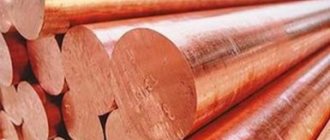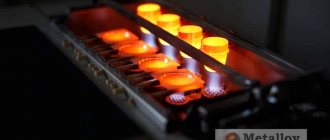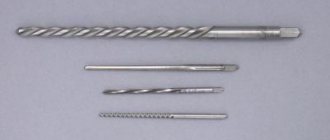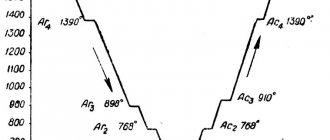Often, for production purposes, it becomes necessary to change the parameters of steel; one way to do this is heat treatment . By their principle, most heat treatment technologies involve changing the structure of steels through heating, holding and cooling.
Despite the fact that all these technologies have the same goals and operating principles, they all differ in temperature and time conditions. Heat treatment can be either an intermediate or a final process during production. In the first case, the material is prepared for subsequent processing, and in the second, new properties are given to it.
One such technology is steel normalization. This is the name for heat treatment, in which the material is heated to a temperature 30-50 degrees above Ast or Ac3, and then it is cooled in still air.
Principles of normalization
Like other heat treatment technologies, normalization can be either an intermediate or a final operation to improve the structure of steel. Most often it is used in the first case; as a final procedure, normalization is mainly used in the production of long products such as rails, channels and more.
The key feature of normalization is that the steel is heated to a temperature that is 30-50 degrees higher than the upper critical values, and the material is also held and cooled.
This or that temperature is selected depending on the type of material. Hypereutectoid materials are normalized at a temperature between points Ac 1 and Ac 3, but hypoeutectoid materials are normalized at temperatures above Ac 3. As a result, materials of the first type obtain the same hardness, since carbon passes into the solution in the same amount, and austenite is also fixed in the same amount. The structure includes cement and martensite.
Thanks to this composition, the wear resistance and hardness of the hypereutectoid material increases. If high-carbon steel heats up above Ac 3, the growth of austenite grains will increase and, accordingly, internal stresses will increase. The carbon concentration will also increase, and as a result, the martensitic transformation temperature will decrease. As a result, the material becomes less durable and hard and can be changed.
And hypoeutectoid steel, when heated above a critical value, becomes very viscous. This is explained by the fact that fine-grained austenite is formed in low-carbon steel. This component, after cooling, transforms into fine-crystalline martensite. Temperature values in the interval between Ac 1 and Ac 3 cannot be used for processing, since in this case the structure of hypoeutectoid steel receives ferrite, which reduces its hardness after normalization, and after tempering, its mechanical properties.
The holding time depends on the degree of homogenization of the material structure. The standard indicator is an hour of exposure per 25 mm of thickness. The intensity of cooling to one degree or another determines the size of the plates and the amount of perlite.
These quantities are interdependent. Even more perlite will form with increasing cooling intensity, reducing the distance between the plates and their thickness. All this increases the hardness and strength of the normalized material. Due to the low cooling intensity, a material with less hardness and strength is formed.
If objects with large differences in cross-section are processed, then the thermal stress must be reduced to prevent warping during heating or cooling. Also, before starting work, they should be heated in a salt bath.
When the temperature of the product decreases to the lower critical point, cooling can be accelerated by placing it in water or oil.
Annealing
The operation is carried out to obtain the required equilibrium structure with minimal hardness, for the purpose of further metal processing of the resulting products by cutting. The video will introduce you to the features:
General definition and types
During casting or other primary processing processes, in addition to stress, defects appear. You can remove these changes and achieve a homogeneous structure of the crystal lattice using the following algorithm of actions:
- heating - it is necessary to slightly exceed the critical level for this type of steel;
- a certain period is required to maintain a stable temperature;
- The workpiece should be cooled slowly along with the oven.
Annealing has the following varieties.
Homogenization
Refers to the first kind, when changes are considered minor. The purpose of such manipulation is to remove the heterogeneity of the structure and bring it to uniformity. In this case, the product should be heated at a temperature range of 1000 to 1150 degrees, then held for about 8-15 hours and gradually reduced heating, cooling the workpiece with oxygen.
Recrystallization
Also a type of annealing phase 1. The purpose of the procedure is to bring all the crystals into a single form, as well as relieve the internal stress of the metal. There are two subspecies:
- softening - usually used as a final treatment, implies an improvement in plastic characteristics;
- strengthening – increases elasticity, especially important for hardening springs.
The temperature is selected depending on the alloy, usually 100-200 degrees higher than the recrystallization point. It is necessary to maintain the temperature for an hour or two, then allow it to cool slowly.
Isothermal annealing
The goal is to achieve high-temperature face-centered modification of iron (decomposition of austenite) to soften it. This results in a more uniform structure of the product. More often, this type of metalworking is used for small stampings, because they can be subjected to rapid cooling without problems. Process:
- heating is 20-30 degrees more than the material limit;
- short aging;
- rapid cooling is an advantage over other subspecies.
To eliminate stress
This is an operation of removing, removing the negative internal state of excessive hardness, due to which the metal becomes brittle and short-lived. It quickly deforms from external physical influences. The process involves temperatures from 700 to 750, then a slight cooling to 600 and holding for up to 20 hours, then slowly cooling under the influence of air.
Complete annealing
Used to create a plastic, uniform fine-grained structure. The most typical method of intermediate impact on rolled metal is after casting, forging, stamping and before cutting by any method. Stages:
- heating is 30-50 more than the steel limit;
- holding;
- very slow cooling with the oven - no more than 50-150 degrees in 60 minutes.
Incomplete
There are no significant transformations at the level of the crystal lattice, but hardness is imparted to previously plastic materials. This is especially necessary for structures formed by welded joints, as well as tools that require special strength. The method involves a temperature of about 700, and after 20 hours gradual cooling.
Purpose of the process
Normalization is designed to change the microstructure of steel; it does the following:
- reduces internal stress;
- through recrystallization, it refines the coarse-grained structure of welds, castings or forgings.
The goals of normalization can be completely different. Using this process, the hardness of steel can be increased or decreased, the same applies to the strength of the material and its toughness. It all depends on the mechanical and thermal characteristics of the steel. Using this technology, it is possible to both reduce residual stresses and improve the degree of machinability of steel using one or another method.
Steel castings are subjected to this treatment for the following purposes:
- to homogenize their structure;
- to increase susceptibility to heat hardening;
- to reduce residual stresses.
Products obtained by forming are subjected to normalization after forging and rolling in order to reduce the heterogeneity of the structure and its banding.
Normalization together with tempering is needed to replace the hardening of products with complex shapes or with sharp changes in cross-section. This will prevent defects.
This technology is also used to improve the structure of the product before hardening, increase its machinability through cutting, eliminate the secondary cement network in hypereutectoid steel, and also prepare the steel for final heat treatment.
Steel grade 45 and its features
This steel is an alloy of iron and carbon. Steel grade 45 due to its hardness is traditionally in high demand in various industrial sectors. In this alloy, the share of iron is about 45 percent. The properties of a material are directly related to its alloying elements and the amount of carbon, which is very important in the production of rolled metal products. This or that temperature treatment allows you to obtain a durable product. After normalization, the hardness of grade 45 is directly related to the temperature during operation.
This steel is carbon structural steel. Normalization should be carried out outdoors, and not in a special oven, unlike other stages of processing. Grade 45 is easily and quickly amenable to mechanical processing, in particular:
- drilling;
- turning;
- milling.
The following products are produced on the basis of this steel:
- bandages;
- cams;
- cylinders;
- gears;
- crankshafts and camshafts;
- gear shaft;
- spindles.
Other heat treatment methods
In addition to normalization, heat treatment of steel includes the following processes:
- annealing;
- hardening;
- vacation;
- cryogenic treatment;
- dispersion hardening.
The principle of implementation and goals of each technology are the same, however, each has its own distinctive features:
- annealing - thanks to it, the structure of pearlite will be as thin as possible, since cooling occurs in the furnace. Annealing can reduce structural heterogeneity, as well as stress after processing by casting or injection, give the structure a fine grain or improve cutting;
- hardening - the technology principle is the same, but the temperatures are higher compared to normalization and the cooling rate is also higher. The process occurs in liquids. Thanks to hardening, the strength and hardness of the material increases, and the parts will eventually have low impact strength and fragility;
- Tempering - Tempering done after hardening reduces stress and brittleness. For this purpose, the material is heated to a low temperature and cooled outside. As the temperature rises, tensile strength and hardness fall, and impact strength increases;
- cryogenic treatment - thanks to it the material will have a uniform structure and hardness; this technology is most suitable for hardened carbon steel;
- dispersion hardening is a final treatment during which dispersed particles are released in a solid solution after hardening at low heat to impart strength to the material.
To perform heat treatment you will need the following:
- tanks with water and oil;
- sanding paper;
- metallographic microscope;
- furnace with thermoelectric pyrometer;
- Rockwell hardness testers;
- sets of microsections (sorbitol, martensite, ferrite-martensite, etc.).
What is the purpose of normalization of steel structures? — machines, welding, metalworking
Often, for production purposes, it becomes necessary to change the parameters of steel; one of the ways to do this is heat treatment. By their principle, most heat treatment technologies involve changing the structure of steels through heating, holding and cooling.
Despite the fact that all these technologies have the same goals and operating principles, they all differ in temperature and time conditions. Heat treatment can be either an intermediate or a final process during production. In the first case, the material is prepared for subsequent processing, and in the second, new properties are given to it.
One such technology is steel normalization. This is the name for heat treatment, in which the material is heated to a temperature 30-50 degrees above Ast or Ac3, and then it is cooled in still air.
The principle of steel normalization
Steel normalization refers to the hardening process through a cycle of heating to a certain temperature and cooling. Heat treatment has different modes for each type of metal. As a result of the use of technology, the material becomes stronger due to the elimination of defects. The latter inevitably appear as a result of previous stages in the manufacture of steel products.
Purpose of technology
Steel normalization can be carried out in a garage if the appropriate equipment is available. The advantage of the technology is the production of a thin eutectoid. The structure of this layer directly affects the strength and rigidity of the metal.
Since steel normalization is carried out to improve the quality of the product, the cost of its production increases accordingly. Technology is used only when necessary. For lightly loaded parts it is not required. It is often applicable for the production of long metal.
The technology can be a replacement for such procedures as hardening with high tempering and classical annealing. Normalization of medium carbon steel does not provide high strength comparable to the structure after quenching. But it does not lead to severe deformation and helps get rid of internal cracks.
The essence of technology
Steel normalization refers to a thermal treatment method. There are several technologies for heating metal, differing in conditions:
- The heating temperature of metals and alloys is different.
- Heated holding time.
- This type of cooling often occurs over a long period of time due to heat exchange with the environment.
Selecting a heat treatment method for steel
Normalization or another method of heat treatment of steel is chosen depending on the concentration of carbon in it. If the material contains it in amounts up to 0.2%, then the most acceptable method is normalization. If 0.3−0.4% carbon is present, then both normalization and annealing will do.
The choice of one or another processing method should also depend on the required properties. For example, normalization will give the product a fine-grained structure, and, compared to annealing, greater hardness and strength.
In many cases, normalization is the most preferred method of processing materials, since it has many advantages over others. In many industries, in particular mechanical engineering, it is most often used for heat treatment .
Improved steels
Improved steels are structural materials:
- carbon;
- low alloyed;
- medium alloyed.
| I | II | III |
| Carbon | low alloy | medium alloyed |
| GOST 1050-82 | GOST 4543-71 | GOST 4543-71 |
| 30-60 | Morganzovye 30G-65G, chromium 30Х-40Х | 38Х2МУА and others, but with a carbon content of no more than 0.4% |
| Chromium-molybdenum 30ХМ-40ХМ, 50Г2 | ||
| Multicomponent 30-40KhGSA, 30-40KhMFA | 45ХН2МФА |
Alloy steels can be divided into several categories:
- chromium;
- chromomanganese (chromansil);
- nickel-containing;
- with the addition of tungsten and molybdenum.
It is especially worth noting the poor weldability of the metals being improved. It is produced subject to certain measures that maintain the required characteristics.











